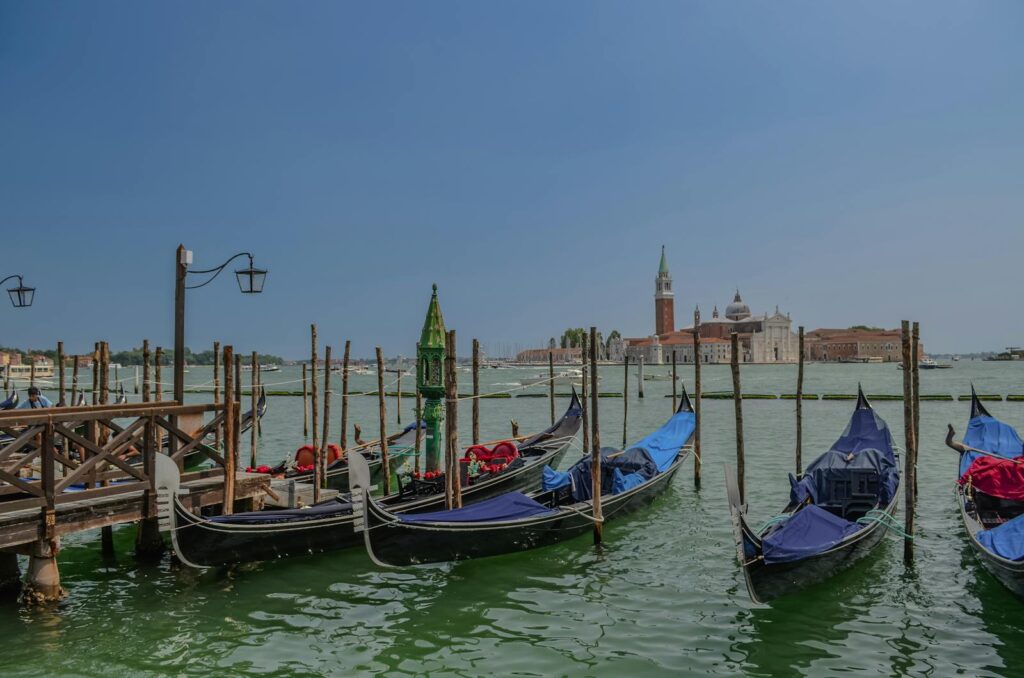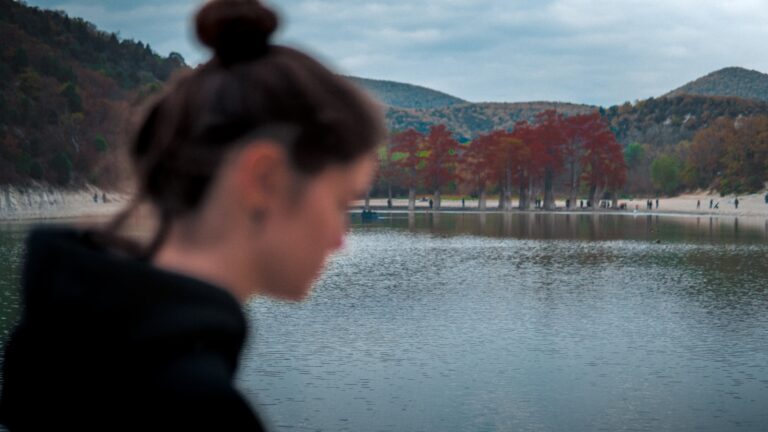WE’VE GOT A GUIDE
From the center of Venice, you can see some attractions. Because I didn’t know where to go with so many things to see, I decided to find a guide. And I met a kind woman who helped me a lot right from the first day. She used to be a tour guide.
During my three official days exploring Venice, each morning, we met at a famous café in Saint Mark’s Square.
This café, the oldest in the world, opened in 1720 and still preserves some 18th-century artworks, resembling a small museum.
It officially opened on December 29, 1720, under the name Alla Venezia Trionfante (Venice Triumphant), and was soon renamed Caffè Florian to honor its owner, Floriano Francesconi. And at a time when all cafes in Venice were closed to women, Caffè Florian was the only one that accepted both genders.

Sitting there, not just to enjoy coffee but also to immerse oneself in a special atmosphere inside the café. It’s like living a part of Venice’s past while immersing yourself in classical music. It seems that this historic café is also a symbol of the luxury and quality of Italian coffee.
Sitting there, you can still see people passing by in the square.
Saint Mark’s Square, 180 meters long and 70 meters wide, not only has the cathedral but also the campanile, which is unrelated to the cathedral. The Venetians affectionately call the campanile—the bell tower—the “guardian saint of homes” because it seems to dominate the square from its height of 98 meters, and, according to folk belief, it protects the homes of the Venetians.
The French newspaper Le Figaro once wrote that the construction of the Campanile was not easy at all. Its structure has also been weakened by various incidents over the centuries. The ground subsided under the weight of the tower in 1080; it had to be completely dismantled and rebuilt a few meters away. Most of the tower was also destroyed in a fire in 1489. In the early 16th century, the tower was threatened by an earthquake.
The bell tower collapsed again in July 1902; it wasn’t until April 25, 1912, that the people of Venice could hold a celebration, ten years after the disaster. Since then, the bell tower has stood firm until today.
A LONG TIME AGO
After the first morning coffee, accompanied by the guide, I left to explore the two most intricate and beautiful monuments of Venice: St. Mark’s Basilica and the Doge’s Palace.
St. Mark’s Basilica dates back to the 11th century, consisting of five domes, 500 columns, some of which date back to the third century. And 4,000 square meters of mosaics on a golden background. This church also has a stone altar.
While listening to the tour guide recount the history of the basilica, I sat on the marble slabs, admiring the golden mosaics.
The Doge’s Palace is a symbol of Venice’s political power, a mark of the city’s wealth and status. Many centuries ago, from here, the dukes and their councils held the power of life and death, governing the entire city of Venice.
Inside the palace is truly magnificent, resembling the most splendid palaces in the world, with golden staircases. Today, the palace still houses many paintings by renowned Italian artists. But there is also a room full of weapons and a prison, where, according to what I’ve read, the famous Giacomo Casanova was once held.
My guide is very professional and knowledgeable. She explained everything I could find in the plaster-covered rooms of the Governor’s Palace, with hundreds of masterpieces, including Tintoretto’s Il Paradiso, the longest canvas painting in the world.
She also introduced the history and context of the Governor’s Palace, helping me walk through the ancient rooms as if I were transported back to medieval Europe.
We continued our stroll to the Long Sigh Bridge. This is not a romantic place where you can hear the sighs of lovers. In fact, this name actually refers to the prisoners who had to pass through there to enter the prison!
Then, we strolled together through the narrow and steep streets of Venice, where the charm of the Middle Ages still lingers. There, the houses look like extensions of the walls.
Then the guide took me to some shops on a street. She helped me chat with the lovely Venetians. There is a kind boss who likes to read books, a smart and witty cashier, and a humorous street vendor. Thanks to that, I got to know more about the joy of some people in the city.
She also took me to an old bookstore, where they sold not only books in Italian but also in French and English. There, I bought the famous novel Aventures de Pinocchio – The Adventures of Pinocchio by Carlo Collodi, French translation. This is the famous novel that has been translated into almost all languages in the world, including Vietnamese.
A LONG TIME AGO
After the first morning coffee, accompanied by the guide, I left to explore the two most intricate and beautiful monuments of Venice: St. Mark’s Basilica and the Doge’s Palace.
St. Mark’s Basilica dates back to the 11th century, consisting of five domes, 500 columns, some of which date back to the third century. And 4,000 square meters of mosaics on a golden background. This church also has a stone altar.
While listening to the tour guide recount the history of the basilica, I sat on the marble slabs, admiring the golden mosaics.
The Doge’s Palace is a symbol of Venice’s political power, a mark of the city’s wealth and status. Many centuries ago, from here, the dukes and their councils held the power of life and death, governing the entire city of Venice.
Inside the palace is truly magnificent, resembling the most splendid palaces in the world, with golden staircases. Today, the palace still houses many paintings by renowned Italian artists. But there is also a room full of weapons and a prison, where, according to what I’ve read, the famous Giacomo Casanova was once held.
My guide is very professional and knowledgeable. She explained everything I could find in the plaster-covered rooms of the Governor’s Palace, with hundreds of masterpieces, including Tintoretto’s Il Paradiso, the longest canvas painting in the world.
She also introduced the history and context of the Governor’s Palace, helping me walk through the ancient rooms as if I were transported back to medieval Europe.
We continued our stroll to the Long Sigh Bridge. This is not a romantic place where you can hear the sighs of lovers. In fact, this name actually refers to the prisoners who had to pass through there to enter the prison!
Then, we strolled together through the narrow and steep streets of Venice, where the charm of the Middle Ages still lingers. There, the houses look like extensions of the walls.
Then the guide took me to some shops on a street. She helped me chat with the lovely Venetians. There is a kind boss who likes to read books, a smart and witty cashier, and a humorous street vendor. Thanks to that, I got to know more about the joy of some people in the city.
She also took me to an old bookstore, where they sold not only books in Italian but also in French and English. There, I bought the famous novel Aventures de Pinocchio – The Adventures of Pinocchio by Carlo Collodi, French translation. This is the famous novel that has been translated into almost all languages in the world, including Vietnamese.




